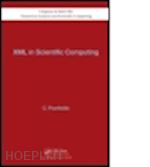
Questo prodotto usufruisce delle SPEDIZIONI GRATIS
selezionando l'opzione Corriere Veloce in fase di ordine.
Pagabile anche con Carta della cultura giovani e del merito, 18App Bonus Cultura e Carta del Docente
While the extensible markup language (XML) has received a great deal of attention in web programming and software engineering, far less attention has been paid to XML in mainstream computational science and engineering. Correcting this imbalance, XML in Scientific Computing introduces XML to scientists and engineers in a way that illustrates the similarities and differences with traditional programming languages and suggests new ways of saving and sharing the results of scientific calculations.
The author discusses XML in the context of scientific computing, demonstrates how the extensible stylesheet language (XSL) can be used to perform various calculations, and explains how to create and navigate through XML documents using traditional languages such as Fortran, C++, and MATLAB®. A suite of computer programs are available on the author’s website.
Text and Data Formatting
Text formatting with latex and html
Formatting with xml
Usage and usefulness of xml files
Constraints on structure and form
Xml data processing
Relevance of xml in scientific computing
Xml Essential Grammar
Xml tags
Xml elements
Comments
Xml document declaration
Character reference
Language processing instructions
Character data (CDATA)
Xml root element
Xml trees and nodes
Document type definition and schema
Xml namespaces
Xml formatting of computer language instructions
Xml Data Processing with Xsl
Xsl processors
The main program
for-each loops
Extracting data with value-of
Repeated parsing
Extracting element attributes
Conditional blocks
Choose, when, and otherwise
Variables and parameters
Templates
Splitting the code
Summary of xsl elements and functions
Passive processing and cascading stylesheets (css)
Computing with Xml/Xsl
Elementary operations
Templates are user-defined functions and subroutines
Further applications of Xslt templates
Square root of a number
Exponential of a number
Natural logarithm of a number
Recursive sequences
Greatest common divisor of two integers
Student roster
Producing and Importing Xml Data
Fortran
Perl
C++
Matlab
Appendix A: ASCII Code
Appendix B Perl Quick Reference
Appendix C: Summary of Xslt Elements
Appendix D: Functions Called by Xslt Elements
Index
C. Pozrikidis is a professor at the University of Massachusetts, Amherst. He is well known for his contributions in fluid mechanics and biomechanics, applied mathematics, and scientific computing. He has published numerous research papers and is the author of eight books and the editor of two contributed volumes.











Il sito utilizza cookie ed altri strumenti di tracciamento che raccolgono informazioni dal dispositivo dell’utente. Oltre ai cookie tecnici ed analitici aggregati, strettamente necessari per il funzionamento di questo sito web, previo consenso dell’utente possono essere installati cookie di profilazione e marketing e cookie dei social media. Cliccando su “Accetto tutti i cookie” saranno attivate tutte le categorie di cookie. Per accettare solo deterninate categorie di cookie, cliccare invece su “Impostazioni cookie”. Chiudendo il banner o continuando a navigare saranno installati solo cookie tecnici. Per maggiori dettagli, consultare la Cookie Policy.